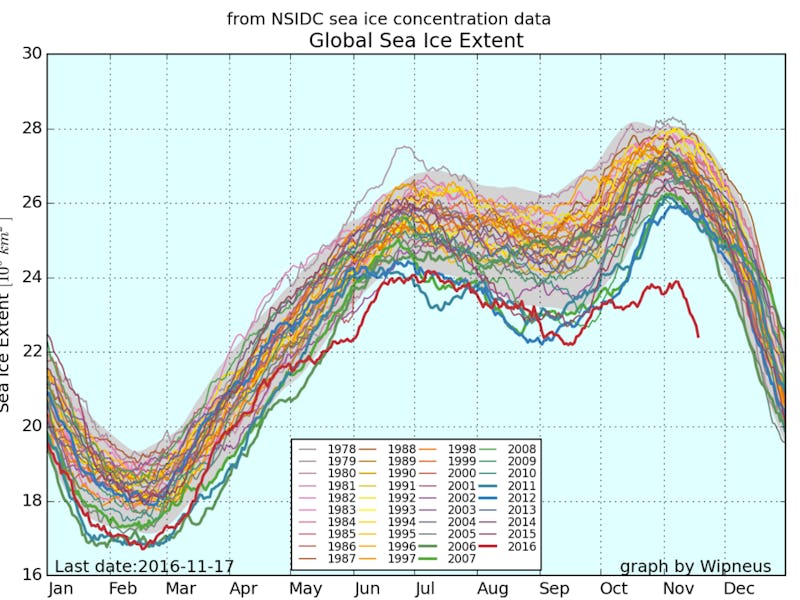2016: The Year Polar Sea Ice Got Scary Weird
Could this be 2016's most frightening graphic?

Normally in November the Arctic would be well into its annual freeze, and Antarctic melt would be just beginning. In fact, right around now is typically the annual high point for global ice cover.
Not so this year. A graph posted to Twitter this week shows that combined polar ice cover is shockingly out of step with normal. In the Arctic, sea ice started to form in September before taking a pause in October, and levels are now at a record low for this time of year. In the Antarctic, spring melt came early making 2016 the second lowest sea ice extent for November on record.
The graph showing the combined effect is so shocking that scientists on Twitter are debating the accuracy of the data, which is publicly available and verifiable through the National Snow and Ice Data Center. One meteorologist commented that a broken sensor in the Southern Hemisphere was to blame, although further discussion found that it had been fixed, and the tweet was deleted.
Others have cautiously suggested that there might be some yet unknown issue with the data, probably coming under intense scrutiny over the next few months.
The NSIDC suggested in a statement to The Verge that total global sea ice cover may not be a great way to think about polar climate systems. “The combined number, while easy to derive from our online posted data, is not useful as an analysis tool or indicator of climate trends. Looking at each region’s ice extent trends and its processes separately provides more insight into how and why ice extent is changing. Sea ice in the Arctic is governed by somewhat different processes than the sea ice around Antarctica, and the very different geography of the two poles plays a large role.”
Arctic sea ice is lower right now than any year on record for mid-November.
This may be true, and yet each polar region’s individual data is pretty terrifying on its own. Surely coincidence has played a significant role in the fact that both the Arctic and Antarctica have veered so far from normal at precisely the same moment, and yet it’s undeniable that both regions are absolutely melting in unprecedented ways as a result of climate change.
Only 1986 had less Antarctic sea ice in November.
The implications of extreme sea ice loss on the rest of the planet are severe. Sea ice melt does not directly increase sea levels, at least not much, because it is already floating. However, huge amounts of sea ice are currently locked up in Antarctic ice shelves, and when those collapse they release an unstoppable flow of glacier ice into the ocean, which does raise the water level. Low-lying nations and coastal cities are already engaged in a losing war against higher tides, worsening erosion, and stronger storms.
Arctic warming has been linked to more persistent weather patterns, which means more intense droughts and also more flooding. Agriculture is already being affected globally, which can lead to more strife, conflict, and war. The Arctic is on track to become completely ice-free at some point in the next 30 years, and the less ice there is, the more heat is absorbed by the Arctic ocean, which exacerbates the problem further.
The world’s situation might seem pretty hopeless at the moment, but it’s equally true that every action to reduce greenhouse gas emissions or prepare for the consequences of climate change will make a real difference to the future of humanity and this planet. That’s why basically every country on Earth is banding together right now under the Paris Agreement to do just that. Let’s hope Donald Trump, who will soon be leading the country with the second highest emission rate, gets the message.